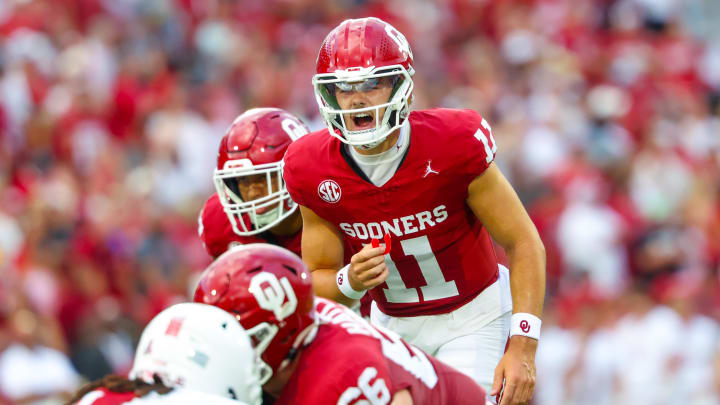COLUMN: How Oklahoma's Young Coaching Staff Uses New Sideline Tech to Its Advantage

NORMAN — A half-dozen times or so in Friday’s season-opener with Temple, the Oklahoma quarterbacks were presented during the ESPN broadcast huddled on the sideline around graduate assistant Ty Hatcher — and his new iPad.
Sophomore starter Jackson Arnold sat to Hatcher’s left, freshman backup Michael Hawkins sat to his right, and behind them, standing up behind the bench, was senior third-team QB Casey Thompson. Hatcher was usually talking, or eliciting a response from Arnold, as they all leaned in to peek at the screen.
They were not scrolling cat videos on YouTube or Instagram shorts, and they were not playing NCAA25.
The tablets are now ubiquitous in college football. Every position group has them, watching plays from the last series and trying to gain an edge for the next series. (In the SEC, teams have an exclusive contract with Apple to use iPads, other conferences have cut other deals.)
For quarterbacks, it would seem an extremely helpful tool to quickly review pass coverages in real time, to make sure protection calls were correct, so see exactly who did what and where, and then communicate any corrections for upcoming drives.
The system is brand new this year, with the NCAA allowing teams up to 18 tablets on game days. So although anyone not on the sideline probably won’t notice it, the whole process should continue to evolve throughout the season.
OU head coach Brent Venables said he likes how the logistics of Friday’s game went.
“I didn’t think there was any issues,” he said Tuesday during his weekly press conference. “I didn’t look at a whole lot. I watched (the game) in person. I saw what just happened. Somebody gave up penetration in the A gap, the quarterback had to throw it early, or whatever. But it is, it’s an excellent resource that everybody has now.“
On the sideline between series, Hatcher gathers up the QBs and opens a line to offensive coordinator Seth Littrell, who’s upstairs in the coaches box with assistant QB coach and offensive analyst Jack Lowary. Littrell tells Hatcher what plays to queue up on the iPad, and they’ll communicate what the play call was, what the defense was doing, and what was good — or what should have happened.
Lowary, Venables said, is “really smart. He’s got some great communication skills.”
“And then Ty’s a good young coach, and he’s helping in all kinds of ways. He’s also facilitating a conversation that’s taking place, making sure they’re on the same play and what have you and the read progression, things like that.”
Lowary and Hatcher are both new to the Oklahoma staff and have both been great assets so far, Venables said. They'll take the next step on Saturday night when the No. 15-ranked Sooners host Houston.
Lowary, from Huntington Beach, CA, was a backup quarterback at Missouri under Barry Odom. His offensive coordinator at the time was Josh Heupel. Lowary also worked at Tennessee for Heupel and Vols offensive coordinator and quarterbacks coach Joey Halzle — which should come in quite handy when the Sooners host Tennessee on Sept. 21.
Hatcher, from Hueytown, AL, was a quarterback at Samford and worked for Jimbo Fisher at Texas A&M last season.
“Great young minds,” Venables said.
On his weekly coaches show Monday night, Venables called it “a player’s worst nightmare” because they no longer have to wait until Sunday film review to get chewed out for a bust.
“You can make it big,” he laughed. “Really zoom in.”
Still, Venables isn’t actually a fan yet of having tablets on the sideline. Venables is old-school to the core, and he thinks giving both teams equal technological assets can somewhat “neutralize” any advantage a talented coaching staff might have.
In other words, one staff puts in overtime on game prep, such as recognizing formations or anticipating pre-snap tendencies — but that mountain of extra work is suddenly leveled because the other sideline can see things in real time on a tablet. Or a school pours financial resources into a salary budget to compensate a top-shelf staff — but any edge in actual coaching skill is taken down a peg because the opponent gets the exact same look.
“Like anything, more isn’t always better,” he added. “If somebody said, ‘Would you vote for everybody to have them or not have them,’ I would say no. Because I like figuring stuff out and seeing it on the field. I think that can be an advantage. Some people can’t see it.
“It still comes down the players out there executing and being physical.”
On Tuesday, he reiterated that stance.
“If you analyzed the iPads as opposed to no iPads, if you asked me, I’d rather not have them. The reason is because I think if you’ve got a good eye for just what happened — who’s in what spot, who wasn’t in the right spot — it gives you a potential competitive advantage on figuring it out. Doesn’t mean you’re gonna win or all of a sudden all of the bad things are gonna go away. But I do think it can be a competitive advantage without the iPads.
“I think it neutralizes a lot of things. I think what you’ve gotta be careful is not overloading information. Most of the time, I think it’s affirmation. ‘Well, that’s what I thought. You’re too wide.’ Or, ‘That’s what I thought. You didn’t block the backside backer.’
“I think it’s a good thing, when it’s all said and done. I think it’s good. … Kind of like the transfer portal has created more parity, I think this will be another thing.”
